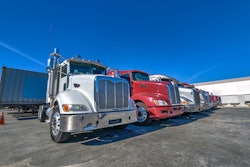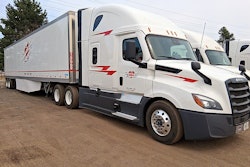Maptuit Corp. (www.maptuit.com) announced that KLLM Transport Services will be deploying FleetNav Directions throughout its national fleet of 1,400 trucks, providing its drivers with truck-to-dock turn-by-turn directions.
ProMiles Software (www.promiles.com) is developing an online routing tool for Oversize/
Overweight (OS/OW) loads within the state of Texas. TxDOT’s new system called TxPROS will cut operating costs while providing easier, more efficient ways of routing, ProMiles says.
Rand McNally (www.randmcnally.com) enhanced its IntelliRoute and MileMaker software products with nearly 70,000 updates to its road network, toll road, truck stop and weigh station information. The 2008 update, available in November, has new HHG miles and routes based on the new Household Goods Mileage Guide 19 rules established by the American Moving and Storage Association.
GE Equipment Services (www.ge.com/transport) announced that Forward Air, a ground transportation carrier serving the air cargo industry, has agreed to equip its entire fleet of 1,900 over-the-road trailers with GE’s VeriWise Trucking trailer management technology.
The Dossier Fleet Maintenance Software Users Group will meet at the Hilton Casino Resort in Atlantic City, N.J., on Oct. 24-25. The agenda includes software training and panel discussions on managing equipment lifecycles, developing and managing fleet budgets, and the hiring, managing and retaining of mechanics and drivers.
Not long ago, fleets could increase their sales through conventional methods such as mailings, personnel visits and repeated phone calls. You might get a sudden bump in freight volumes just by taking customers out to lunch.
Today, the formula for success has changed. Shippers don’t like random calls by carriers asking about opportunities to do business. Increasingly, even small and midsize shippers and third-party logistics firms are using advanced transportation management software (TMS) to optimize their network in terms of pricing, coverage and performance.
The good news is that technology has leveled the playing field by automating the decisions as to which carrier gets what freight. Personal, one-on-one relationships may not matter as much as they used to, but price and performance is going a long way toward filling that gap.
One company that has led the movement toward unbiased carrier selection is Transplace – a major 3PL and technology provider with a $2.5 billion annual freight spend. Transplace recently created a carrier management group that consists of nine members. The job responsibility of each member is strategic – not transactional – by nature. Collectively, the group’s role is to find and reward the capacity in Transplace’s system that meets its highest standards.
“The carrier side is of equal importance to the customer side,” says Roy Cashman, chief operating officer of Transplace.
The carrier management group scores, ranks and certifies carriers into one of three tiers: platinum, silver and bronze. The ranking is based on performance in areas that include automation, on-time service and customer service. Incidentally, customer service is one of the few slightly subjective measurements where personal relationships can make a difference, Cashman says.
Once carriers are certified into one of three levels, they are prioritized and assigned to individual account teams. The teams work with carriers one on one to identify new freight opportunities in Transplace’s freight network. One type of opportunity is to create routine dispatches for continuous moves or roundtrips. This opportunity represents a small percent of its business, but has proven to be effective, especially with smaller carriers and private fleets.
“(Continuous moves) is a high-service product,” Cashman says. Often, the fleets that participate in continuous moves rise up in performance by gaining an in-depth understanding of the needs of each customer, such as freight handling and appointment times, he says.
As Transplace identifies new business opportunities and carriers agree, Transplace sets up lanes in its carrier routing guide. The rest is automated through electronic transactions – load tenders, status updates, invoices, etc. – that move between carriers and Transplace’s information systems.
For carriers that don’t have electronic data interchange (EDI), Transplace offers a Web suite that allows carriers to see and accept tendered loads, and to make appointments for delivery times.”As long as it is an electronic touch on our end, we’re satisfied,” Cashman says.
If the primary carrier for a lane chooses to reject a load, Transplace uses a Freight Allocation Module (FAM) to tender the load to a secondary carrier for the lane. Afterward, if the load is still available, the FAM automatically makes the load available to all carriers that have priority status.
Carriers that aren’t set up in Transplace’s software – and other TMS systems, for that matter – and aren’t ranked with priority status probably shouldn’t expect that a phone call or lunch appointment will change the outcome. But while TMS systems have made carrier selection and load tendering an automated process, automation by itself is not the answer.
Shippers and their core carriers must be able to identify new business opportunities within their networks of freight and capacity. To address these needs, TMS provider Best Transport on Aug. 1 announced the release of a platform for freight matching and collaboration called BestMatch.
Best Transport provides a TMS system called Best Shipper and an online load tendering module for carriers called Best Carrier. The new BestMatch platform was developed in an exclusive partnership with the National Industrial Transportation League, a consortium of leading shippers, to compliment TMS systems – that of Best Transport or any of its competitors – by inputting files directly from a TMS.
Shippers often miss opportunities with their core carriers because they don’t know a certain carrier has a truck in a route pattern that is close to something else they need to move. They didn’t discuss it, and the carrier didn’t ask, says Bob Parsely, vice president of marketing for Best Transport. Likewise, shippers continually have missed opportunities with carriers they don’t do a lot of business with – or any business at all.
The shippers that use BestMatch all have made a commitment to expose more of their freight planning and forecasting in real time, Parsely says. Likewise, carriers who participate make a commitment to provide their capacity information in real time.
“This is not being used as a market auction platform,” says Mark Shary, president of Best Transport. “BestMatch is helping to enable planning with key customers.” BestMatch also gives carriers the ability to solicit freight, depending on what level of visibility shippers allow among their carrier community.
The people who have shown the most interest in BestMatch thus far are senior-level salespeople at carriers, some of whom have compared the tool to radar, Shary says. BestMatch gives them the ability to look “on the horizon” from a central source to see what kind of patterns are developing for loads in what lanes.
“(BestMatch) is a very quick means of reaching out to a shipper and asking them if they are interested in discussing further,” Parsely says.
In the early stages of BestMatch, Shary has seen carriers increase business with key customers by multiples – not because they weren’t already talking, but because the real-time visibility gave both parties confidence to rearrange supply and demand.
TMW Systems acquires IDSC
TMW Systems, a provider of enterprise management software to the North American transportation industry, acquired Integrated Support Decision Corp. (IDSC), a provider of optimization-based decision support software for the trucking industry. IDSC’s software is designed to work with all major dispatch and operations software platforms, providing solutions to carriers looking to achieve higher revenue per loaded mile, control the route and minimize fuel and out-of-route costs. Terms of the acquisition were not disclosed.
“This announcement represents one more step in our strategy to create a portfolio of solutions to the transportation industry of unprecedented breadth, quality and value,” says Dave Wangler, president and chief executive officer of Cleveland-based TMW Systems. “TMW’s mission is to deliver products that deliver compelling competitive advantage with a minimum of risk for customers.”
TMW says that with IDSC’s decision support solutions combined with its own ERP and fleet maintenance applications, it can provide a seamless solution for the results-driven trucking company, or focused complementary solutions that address specific needs. In addition, IDSC’s TruckloadRate.com and FuelAdvice.com add significant strength to TMW’s broad portfolio of Internet-based applications, according to TMW.
Customers of both companies will benefit from this acquisition through expanded products and services, broader geographic reach and greater scale, TMW says. TMW Systems already has extended its Lifetime Support Policy to include IDSC’s entire product line.
TMW plans to accelerate growth of IDSC products, expand R&D investments and increase employment. “With access to TMW’s more than 1,500 customers, and TMW’s considerable technology, personnel and financial resources, we have an unparalleled opportunity to grow our customer base,” says Richard Murphy, CEO of Richardson, Texas-based IDSC.
Customers will see additional improvements in support, accelerated innovation and improved integration, IDSC says; all of its products will be supported, enhanced and expanded, including Netwise Enterprise, Netwise Frontline, Match Advice Netwise Supply Chain, Expert Fuel, Trip Alert, Route Advice, TruckloadRate.com and FuelAdvice.com.
AOS, ObjectFX develop browser- based solution
Add On Systems (AOS), a developer of trucking software for the System i server, has partnered with ObjectFX to deliver a product called FleetScape designed to give fleet executives and managers a new browser-based interface to streamline decision making.
AOS says the new FleetScape product will allow users to pull up a dynamic map on a Web browser that shows a variety of information about their operations, including the location of trucks, trailers, containers, warehouses, fuel stops, repair facilities and drop yards.
The software also will provide a variety of analytics designed to help companies monitor and improve their operations. FleetScape is scheduled to be available in the fourth quarter.










